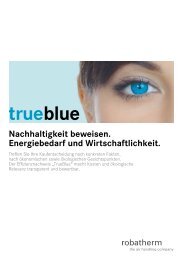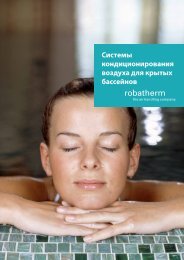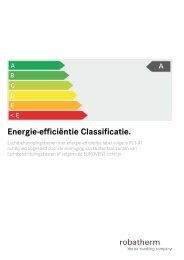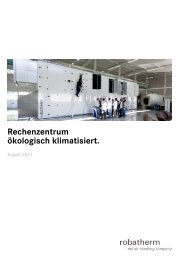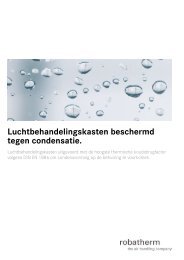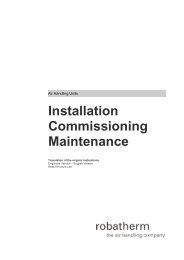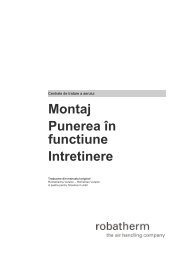English - robatherm
English - robatherm
English - robatherm
You also want an ePaper? Increase the reach of your titles
YUMPU automatically turns print PDFs into web optimized ePapers that Google loves.
Air Handling Systems<br />
for Medical<br />
Applications
Applications | 1<br />
Hygiene and Comfort<br />
for Effective Healing.<br />
A hygienically impeccable and comfortable room climate<br />
supports and accelerates the healing process. Treatment times<br />
are reduced and costs saved.<br />
The health care sector is marked by an<br />
increasing cost pressure on medical facilities.<br />
Hospitals, in particular, must reconcile the task<br />
of cutting costs with the need for improving the<br />
quality of their services in the face of increasing<br />
competition.<br />
Hygiene in a hospital is a self-evident prerequisite<br />
to the quality of services. Avoiding hospitalacquired,<br />
or so-called nosocomial infections, is<br />
top priority.<br />
During surgical interventions, wound contamination<br />
is caused by the patient’s own flora (endogenous<br />
infection) or by pathogens from external<br />
sources (exogenous infection), such as the<br />
surgical staff.<br />
or at least dilute the pathogen concentration<br />
at the wound site to an unobjectionable level, by<br />
means of a flow of ultra-purified air.<br />
Especially in aseptic interventions posing a very<br />
high risk of infection, as is the case in joint<br />
implantations and in trauma surgery, air handling<br />
systems have to meet the highest demands. A<br />
hygienically impeccable and comfortable room<br />
climate creates a medically safe and undisturbed<br />
treatment environment. Additionally, patients’<br />
treatment times are reduced to the minimum<br />
medically required, avoiding unnecessary long<br />
hospital stays. At the same time, the hospital’s<br />
operation costs can be reduced, and the staff’s<br />
work performance is maintained at a constant<br />
high level.<br />
AHUs provide a<br />
constant, comfortable<br />
room climate.<br />
Faster patients’<br />
recovery.<br />
Improved safety<br />
for patients and<br />
doctors.<br />
Enhanced work<br />
performance.<br />
Air handling systems are, therefore, indispensable<br />
for reducing or avoiding the introduction of<br />
airborne pathogens into the wound. They are<br />
designed to keep pathogens away from wounds,<br />
With regard to quicker recovery, enhanced comfort<br />
and a safe work environment, air handling<br />
systems for medical applications should be given<br />
particular attention.
2 | General requirements<br />
Highest Demands<br />
on Air Handling<br />
Technology.<br />
A multitude of factors need to be considered<br />
to meet the high demands on air handling systems<br />
while ensuring cost-effectiveness.<br />
Ensure comfort for<br />
patients and staff.<br />
Clean air thanks to<br />
professional design<br />
and maintenance.<br />
Operating times<br />
between 5,000 h and<br />
8,760 h per year.<br />
Integration of<br />
compressors in<br />
AHUs saves space,<br />
increases the COP<br />
and facilitates<br />
maintenance.<br />
Primary-energy<br />
demand reduced, e. g.<br />
by using reversible<br />
heat pumps for heat<br />
recovery.<br />
The main tasks of air handling systems<br />
include supplying a sufficient amount of oxygen,<br />
removing carbon dioxide and maintaining a<br />
comfortable room climate that is unobjectionable<br />
from the viewpoint of climate-physiology.<br />
In rooms having to meet special requirements,<br />
such as operating theatres, the supply air has<br />
further functions. The air handling system must<br />
also act as a barrier screening the specified<br />
protected area, reduce the concentration<br />
of microorganisms, provide temperature and<br />
humidity control and remove odours and<br />
contaminants.<br />
Air cleanliness<br />
Air cleanliness is of particular importance in<br />
hygiene applications. Air filters here fulfil a combination<br />
of several tasks: They protect patients<br />
and staff from infections, and air handling units<br />
(AHUs) and the ductwork from contamination.<br />
Scrupulous checking of filters for clogging prevents<br />
the ingress of dust and cuts the operating<br />
cost of the system as the pressure drop across<br />
filters is reduced.<br />
Operation times<br />
Depending on the medical facility, the operating<br />
hours of air handling systems may vary considerably:<br />
In hospitals, for instance, they range<br />
between 5,000 h/a and 8,760 h/a (non-stop<br />
operation). From the viewpoint of hygiene and<br />
energy consumption, but also for reasons of<br />
operational reliability, plug fans combined with<br />
frequency converters and energy-efficient<br />
motors are particularly convenient here. This<br />
combination offers highest efficiencies along<br />
with low operating costs.<br />
Integrated chillers<br />
Air conditioning by means of air handling units<br />
(AHUs) is required to create a comfortable<br />
room climate and a safe work environment.<br />
Ideally, the necessary refrigeration equipment<br />
is integrated directly into the AHU, which<br />
helps to save space in the engineering room.<br />
No further external devices are required, and<br />
considerably less sound is emitted to adjacent<br />
buildings. Also, the coefficient of performance<br />
(COP) of the refrigeration system is more<br />
favourable as the condensation temperature<br />
of exhaust-air-cooled condensers is lower than<br />
that of axial condensers installed outdoors.<br />
Moreover, the entire equipment is accessible<br />
for maintenance in one place, and its operation<br />
is more reliable compared to central external<br />
chilling.
Experimental operating theatre,<br />
Tübingen University Hospital.<br />
General requirements | 3<br />
New concepts<br />
Innovative heat recovery systems significantly<br />
reduce the primary-energy demand of an air<br />
handling system. A reversible heat pump, for<br />
instance, allows cooling the air in summer and<br />
heating the air in winter. Additionally, electrical<br />
energy for driving the fans is saved, because<br />
only one heat exchanger is required in the air<br />
supply. The supply- and extract-air flows remain<br />
separated, without any risk of contamination of<br />
the supply air.<br />
Important standards and guidelines pertaining to hospitals<br />
Requirements regarding buildings ... regarding air handling systems ... regarding air handling units<br />
European Energy Performance of<br />
Buildings Directive (EPBD)<br />
Act on the saving of energy in buildings<br />
Energy Savings Act (EnEG) |1<br />
National implementation of the EPBD<br />
Renewable Energies Heat Act<br />
(EEWärmeG) |1<br />
Act on the promotion of renewable<br />
energies in the heating sector<br />
Energy Savings Ordinance (EnEV) |1<br />
Ordinance on energy-saving thermal<br />
insulation and energy-saving installations<br />
in buildings<br />
DIN V 18599 |1<br />
Energy efficiency of buildings<br />
DIN 13080 |1<br />
Division of hospitals into functional areas<br />
and functional sections<br />
EN 13779<br />
Ventilation for non-residential buildings<br />
EN 15242<br />
Calculation methods for the determination<br />
of airflow rates in buildings including<br />
infiltration<br />
EN 15251<br />
Indoor environmental input parameters<br />
for design and assessment of energy<br />
performance of buildings<br />
EN 15780<br />
Ventilation for buildings – Ductwork –<br />
Cleanliness of ventilation systems<br />
DIN 1946-4 |1<br />
Ventilation in buildings and rooms of<br />
health care<br />
VDI 2081 |1<br />
Noise generation and noise reduction in<br />
air-conditioning systems<br />
Hygiene requirements for surgical<br />
and other invasive interventions<br />
Commission for hospital hygiene and infection<br />
prevention (Robert-Koch Institute)<br />
EN 13053<br />
Rating and performance for units,<br />
components and sections<br />
EN 1886<br />
Mechanical performance and measurement<br />
methods<br />
DIN 1946-4 |1<br />
Ventilation in buildings and rooms of<br />
health care<br />
VDI 3803 |1<br />
Air conditioning systems – Structural and<br />
technical requirements<br />
VDI 6022 |1<br />
Hygienic requirements for ventilation and<br />
air conditioning systems and air handling<br />
units<br />
AHU-Guideline 01 |1<br />
Herstellerverband Raumlufttechnische<br />
Geräte e.V. – General requirements for<br />
air handling units<br />
|1<br />
Valid in Germany; deviating or additional national rules and regulation to be observed as well!
4 | Design requirements<br />
Hygiene Thanks to Well-<br />
directed Airflow Routing.<br />
The selection of the system for supplying air<br />
into the operating field is determined by the room class<br />
and the ensuing hygiene requirements.<br />
Specification<br />
of room classes<br />
performed by the<br />
hospital-hygiene<br />
specialist.<br />
Conditioned<br />
supply air suffices to<br />
establish a protected<br />
area in the operating<br />
theatre.<br />
Supply-air<br />
temperature below<br />
indoor temperature.<br />
Positioning<br />
of extract- and<br />
recirculation-air<br />
openings in lower<br />
wall sections.<br />
“Surgery mode”<br />
must be selectable<br />
by pushbutton in the<br />
operating theatre.<br />
Scientific findings revealed, that<br />
pathogens transmitted through the air, so-called<br />
airborne microorganisms, pose but a minor risk<br />
of infection. The classification of rooms has,<br />
therefore, been revised. The required protected<br />
area is maintained only where absolutely<br />
imperative.<br />
Room class Ia<br />
Aseptic interventions subject to particularly<br />
strict requirements in terms of hygiene, as is the<br />
case e. g., in trauma surgery or orthopaedics.<br />
Room class Ib<br />
Medical interventions subject to high requirements<br />
in terms of hygiene, such as encountered<br />
in minimally invasive surgery or, in parts, in<br />
intensive-care wards.<br />
Room class II<br />
Other rooms and areas not allocated to room<br />
classes Ia or Ib, such as rooms ancillary to<br />
operating theatres, or anaesthetic recovery<br />
rooms, observation rooms and pre-operative<br />
rooms.<br />
Special areas<br />
Rooms where additional precautions are taken,<br />
such as isolation rooms (negative pressurisation<br />
with room-side H13 particulate extract-air<br />
filters), sterile-care rooms (positive pressurisation<br />
with room-side H13 particulate supply-air<br />
filters) or central sterilisation units (packaging<br />
zone under positive pressure with respect to the<br />
cleaning zone).<br />
Air flow rates<br />
Given a passage velocity of 0.25 m/s, a<br />
unilateral-flow supply-air diffuser measuring 3.2 m<br />
x 3.2 m will yield a volume flow rate of approx.<br />
9,200 m 3 /h per operating theatre. Thus, at a<br />
minimum outdoor-air flow rate of 1,200 m 3 /h,<br />
an additional supply of approx. 8,000 m 3 /h will<br />
be required. For this reason, systems relying<br />
exclusively on outdoor air are no longer stateof-the-art<br />
equipment.<br />
Supply-air temperature<br />
A low-turbulence air curtain will only form if<br />
the temperature of the supply air is constantly<br />
below that of the indoor air. The greater<br />
the temperature difference, the more stable<br />
the protected area will be. An excessive temperature<br />
difference, however, will have an utterly<br />
adverse effect on the energy demand and<br />
on the surgical staff’s comfort and well-being.<br />
Static panel heaters must be provided. In<br />
room class Ia, however, underfloor heating is<br />
inappropriate as it counteracts the unilateral<br />
air flow.
Design requirements | 5<br />
Air discharge openings<br />
As a matter of principle, extract-air, recirculated-air<br />
and overflow openings should be located<br />
in the lower wall sections. Air will thus leave<br />
the room with the least possible turbulence<br />
(extract-air openings with lint screens).<br />
Operating modes<br />
A constant volume flow rate is prerequisite<br />
to the reliable formation of a protected area.<br />
In operating theatres with unilateral air flow<br />
supply-air diffusers, the operating modes<br />
“Surgery” and “Sustainment” are mostly<br />
used. It must be possible for the surgical staff<br />
to switch on the surgery mode by activating<br />
a pushbutton in the operating theatre. During<br />
sustainment mode, the unilateral air flow<br />
need no longer be maintained. Outside<br />
surgery times, less energy is thus required<br />
for heating and cooling as well as for the fan<br />
driving.<br />
Design<br />
Modern air-conditioning layouts for operating<br />
theatres are based on central conditioning of<br />
outdoor air plus a central or local treatment of<br />
recirculated-air. In case of indoor-air recirculation,<br />
central systems are beneficial because outdoor<br />
air and recirculation air will be completely homogeneously<br />
mixed. No cooling below dew point can<br />
occur inside the unilateral air flow diffuser. In addition,<br />
the permissible sound pressure levels are<br />
easier to observe. Furthermore, all components<br />
provide greater ease of access for maintenance.<br />
Control<br />
The nominal temperature must be selectable by<br />
a control element in the operating theatre. This<br />
nominal value is compared to the extract-air<br />
temperature. The temperature rise due to internal<br />
room loads is compensated by means of the<br />
supply air. The supply-air temperature is thus sure<br />
to be below indoor-air temperature.<br />
Room classes and air routing systems |1<br />
Room class Ia Room class Ib Room class II<br />
Rooms subject to very strict<br />
hygiene requirements<br />
Rooms subject to increased<br />
hygiene requirements<br />
Rooms subject to general<br />
hygiene requirements<br />
Dynamical screening of the<br />
protected area<br />
Static pressurisation<br />
Overflow / air-mixing principle<br />
Ensuring the protected area around the operating<br />
table, surgical staff and medical instruments<br />
table by means of a stable top-to-bottom unilateral<br />
air flow.<br />
Positive air balance.<br />
Higher velocities in unilateral air flow centre<br />
improve protective effect.<br />
Supply-air temperature below indoor-air<br />
temperature.<br />
3-stage filtration (at least F5/F9/H13).<br />
Constant pressurisation with respect to ancillary<br />
rooms. Air intake by non-unilateral or unilateral<br />
air flow. Directed overflow of at least the volume<br />
of the minimum outdoor-air fraction.<br />
Introduction of particles by humans or through<br />
open doors cannot be prevented.<br />
Positive air balance.<br />
No separate protected area.<br />
3-stage filtration (at least F5/F9/H13).<br />
Air intake can be based on the overflow principle<br />
or on the air-mixing principle with a neutral air<br />
balance. For these areas, provide an airflow pattern<br />
that ensures high ventilation effectiveness<br />
and quick removal of any contaminants from the<br />
emission source.<br />
For hygienically relevant areas, the<br />
requirements of VDI 6022 |1 apply.<br />
2-stage filtration (at least F5/F9).<br />
|1<br />
Valid in Germany; deviating or additional national rules and regulation to be observed as well!
6 | Practical implementation<br />
Design.<br />
Cornerstone<br />
ODA<br />
of Success.<br />
Solution-oriented job implementation.<br />
EHA<br />
RCA<br />
Boundary conditions<br />
to be defined at an<br />
early stage of design.<br />
A specification<br />
sheet forms the<br />
basis of a contract.<br />
Experience joins<br />
rules of technology to<br />
facilitate design.<br />
In general<br />
Analysis stage<br />
Actual-state inventory and assessment of<br />
building project.<br />
Basic evaluation including process<br />
description. Planning of available resources.<br />
Identification of infrastructure and drafting<br />
of job description.<br />
Compilation of current standards.<br />
Analysis stage finalised upon signature<br />
of the declaration of intent for drafting a<br />
requirements specification.<br />
Goal-definition stage<br />
Analysis of utilisation requirements<br />
(utilisation concept, intended range of<br />
surgical services, comfort conditions,<br />
deadlines, design data, occupancy, additional<br />
internal loads, periods of use, etc.).<br />
Drafting of a requirements specification<br />
on the basis of current standardization<br />
(hygienic acceptance test of unilateral air<br />
flow system, specification of cleaning<br />
procedure, etc.).<br />
Design guidance |1, 2<br />
Air handling systems<br />
Outdoor-air intakes at least 3 m above<br />
ground level.<br />
Outdoor air taken in without interference<br />
from emission sources. Provide openings<br />
for drainage and cleaning.<br />
No outdoor-air intakes along the main<br />
wind direction; for roof intakes, observe<br />
a minimum distance to the surface of<br />
1.5 x snow height.<br />
Exhaust-air discharge via the roof.<br />
Install silencers, heat exchangers and dampers<br />
in the AHU (for ease of maintenance).<br />
Volume flow controllers and shutoff<br />
dampers to be installed in the mechanical<br />
equipment rooms, where possible.<br />
Position and size of inspection openings<br />
must be indicated in the ground plan.<br />
Inspection openings in air ducts.<br />
Both sides: heat exchangers, silencers,<br />
heat recovery.<br />
Approval of project requirements specification<br />
at the beginning of the design stage.<br />
Design stage<br />
Implementation of design in accordance<br />
with the specification sheet. Implementation<br />
of design in terms of hygiene (cleaning),<br />
maintenance (accessibilities), safety<br />
concepts (redundancy, self-closing dampers,<br />
etc.) and any specific requirements.<br />
Coordination of the initial, and all further,<br />
hygiene inspections by qualified specialists<br />
(VDI 6022, Category A).<br />
Updating of the standards list upon<br />
finalisation of the design stage.<br />
One side: dampers, fire dampers, volume<br />
flow controllers.<br />
Flexible air ducts only permissible<br />
for connections to air terminal units<br />
(Lmax. = 1.0 m).<br />
Max. permissible specific leakage of air<br />
ducts must correspond to Class C as<br />
defined in DIN EN 13779.<br />
Localised emissions to be removed directly.<br />
Prefer pressure regulation where constant<br />
volume flows are ensured by volume flow<br />
controllers.<br />
Make sure that AHU allows access on both<br />
sides (half a unit width at rear, full unit width<br />
at front).
Practical implementation | 7<br />
ETA<br />
SUP<br />
Outdoor<br />
Temperature<br />
Winter: - 16 °C to +12 °C<br />
Summer: 28 °C to 35 °C<br />
Humidity<br />
Summer: 37 % r. h. to 64 % r. h.<br />
(12 g/kg to 14 g/kg)<br />
(temperature and<br />
humidity depending<br />
on climatic conditions)<br />
Sound pressure level (TA-Lärm) |1<br />
Daytime (6h-22h):<br />
Residential areas: 55 dB (A)<br />
Mixed-use areas: 60 dB (A)<br />
Commercial areas: 65 dB (A)<br />
Industrial areas: 70 dB (A)<br />
Night-time (22h-6h):<br />
Residential areas: 40 dB (A)<br />
Mixed-use areas: 45 dB (A)<br />
Commercial areas: 50 dB (A)<br />
Industrial areas: 70 dB (A)<br />
Minimum outdoor-air rate<br />
Operating theatres: 1,200 m 3 /h<br />
Intervention rooms: 40 m 3 /(h·pers.) or<br />
150 m 3 /(h·patient)<br />
where anaesthetic<br />
gases are used<br />
Intensive-care area: 40 m 3 /(h·pers.) or<br />
> 100 m 3 /(h·patient)<br />
Other rooms, corridors<br />
(intensive care): 5 m 3 /(h·m 2 )<br />
Design parameters |1, 2<br />
Indoor<br />
Indoor-air temperature |2, 3<br />
Winter:<br />
OP theatres (Classes Ia, Ib): 19 °C to 26 °C<br />
(selectable from inside the operating theatre)<br />
Intervention rooms (Class II): 22 °C to 26 °C<br />
Intensive-care area: 22 °C to 26 °C<br />
Standard-care rooms: 22 °C<br />
Baby-care rooms: 24 °C<br />
Examination rooms: 22 °C<br />
Kitchenettes, corridors: 20 °C<br />
Sterilisation: 20 °C<br />
Storerooms: 18 °C<br />
Summer:<br />
OP theatres (Classes Ia, Ib): 19 °C to 26 °C<br />
Intervention rooms (Class II): 22 °C to 26 °C<br />
Intensive-care unit: 22 °C to 26 °C<br />
Standard-care rooms: 26 °C<br />
Baby-care rooms: 26 °C<br />
Examination rooms: 26 °C<br />
Kitchenettes, corridors: 28 °C<br />
Sterilisation: 28 °C<br />
Stores:<br />
depending on<br />
goods stored<br />
Indoor humidity<br />
Intensive-care rooms:<br />
30 % r. h. to<br />
60 % r. h.<br />
(mandatory year-round)<br />
Other rooms:<br />
Winter: 25 % r. h. |5<br />
Summer:<br />
Sound pressure level |4<br />
Operating theatres:<br />
Wards:<br />
Bedrooms:<br />
Corridors:<br />
60 % r. h. |5 or<br />
max. 12 g/kg |5<br />
48 dB(A)<br />
25 dB(A) to 35 dB(A)<br />
25 dB(A) to 35 dB(A)<br />
35 dB(A) to 45 dB(A)<br />
|1<br />
Valid in Germany; deviating or additional design parameters to be observed in accordance with the national requirements!<br />
|2<br />
For further information, also on the design of buildings and the use of air handling systems, see DIN EN 13779 and DIN 1946-4.<br />
|3<br />
Values correspond to the operative temperatures.<br />
|4<br />
Details concerning indoor-air temperatures and permissible sound pressure levels are to be found in the table issued by<br />
Deutsche Gesellschaft für Krankenhaushygiene.<br />
|5<br />
Recommendation based on DIN EN 15251, Category II.
8 | Solutions made by <strong>robatherm</strong><br />
Safety and<br />
Hygiene.<br />
Solutions Made<br />
by <strong>robatherm</strong>.<br />
AHU concepts specifically optimised<br />
to suit your application.<br />
Custom-built<br />
and optimized for your<br />
needs.<br />
Excellent hygiene characteristics<br />
of the <strong>robatherm</strong> AHUs<br />
were tested and certified by the<br />
Berlin Institute for Air Hygiene<br />
range from 1,000 m 3 /h to<br />
320,000 m 3 /h, the <strong>robatherm</strong><br />
product line meets a wide variety<br />
of customer requirements.<br />
Proven mechanical stability<br />
The rugged and proven construction<br />
of the AHUs includes,<br />
among others, powder-coated<br />
High<br />
hygiene standard and<br />
high product quality.<br />
Certified<br />
energy efficiency in<br />
accordance with<br />
EUROVENT and<br />
German AHU manufacturers’<br />
association.<br />
(Institut für Lufthygiene, ILH).<br />
Proper operation and maintenance<br />
provided, our hygiene<br />
AHUs will ensure hygienically<br />
impeccable air quality. Moreover,<br />
the operating costs of<br />
the optimally configured<br />
AHUs have been reduced to<br />
a minimum.<br />
High variability<br />
With its outstanding versatility<br />
Restrictions in available space<br />
or particular installation conditions<br />
are taken into account at<br />
the project design stage.<br />
Excellent hygiene<br />
Periodic maintenance ensures<br />
hygienic conditions throughout<br />
the life time. The maintenancefriendly<br />
<strong>robatherm</strong> AHUs ensure<br />
impeccable cleaning as all<br />
components are arranged in the<br />
galvanised sheet as a standard.<br />
Stainless steel is available<br />
as well.<br />
Low heat losses<br />
A panel construction with<br />
thermal break guarantees very<br />
high thermal insulation and<br />
high air tightness. The energy<br />
demand is minimised, as is<br />
the tendency of condensation<br />
inside the casing.<br />
Integrated<br />
control- and refrigeration<br />
technology.<br />
and the broad throughput<br />
unit to be easily accessible.
Experimental operating theatre, Tübingen University Hospital.<br />
Easy assembly<br />
The modular design of the <strong>robatherm</strong><br />
AHU means a minimum<br />
of sections to be assembled.<br />
This significantly saves time<br />
at site. Sturdy internal casing<br />
connections facilitate assembly<br />
even further. In particular, the<br />
factory integration of control<br />
and refrigeration components<br />
and chillers that contributes<br />
to expediting installation and<br />
commissioning of the AHUs.<br />
Shorter standstill times are thus<br />
achieved, above all in case of<br />
replacements.<br />
Low energy demand<br />
The top efficiency classes are<br />
reached as a result of smart<br />
dimensioning and the use of<br />
optimised built-in components.<br />
Our AHUs are certified in<br />
accordance with the energyefficiency<br />
classes of the<br />
Herstellerverband Raumlufttechnische<br />
Geräte e.V. and<br />
the guideline of the European<br />
certification body EUROVENT.<br />
The physical characteristics<br />
of the AHU casing as specified in DIN EN 1886:<br />
Thermal transmittance: Class T2<br />
Thermal bridges: Class TB2<br />
Casing leakage: Class L1 (M), L2 (R)<br />
Filter bypass leakage: Class F9<br />
Casing deflection: Class D1/D2
10 |Integrated control and cooling technology<br />
Detailed Optimisation.<br />
Controls and Cooling<br />
Combined Logically.<br />
Customized, factory-integrated control systems and chilling<br />
equipment allow you to make the most of potential savings.<br />
Everything<br />
from a single source.<br />
On-site<br />
installation work and<br />
cost reduced.<br />
No distribution<br />
and standstill losses.<br />
Integrated<br />
refrigeration without<br />
external units.<br />
Reversible<br />
heat pump.<br />
Central multifunctional<br />
AHUs<br />
are ready for plug in.<br />
The control system is optimally<br />
adjusted at the factory. The various thermo-<br />
dynamical requirements to be met by a<br />
central AHU can thus be fulfilled along with<br />
optimising the operating cost. For this reason,<br />
<strong>robatherm</strong> has developed the DDC software<br />
“Smart Control”.<br />
Control technology<br />
Instrumentation and control are integrated<br />
into the AHUs at the <strong>robatherm</strong> factory. All<br />
that remains to be done is parameterising the<br />
function blocks of the control system. The<br />
commissioning cost is, therefore, minimal.<br />
Integrated maintenance management<br />
The maintenance management included in<br />
Smart Control records immobilisation and<br />
operating times of the components and<br />
automatically generates inspection reports<br />
which are displayed in plain text. Appropriate<br />
descriptions of the components are also<br />
given.<br />
Particularly in AHUs for hygiene applications, the<br />
maintenance management ensures increased<br />
operational reliability and hygienically impeccable<br />
conditions.<br />
Communicative and open<br />
Various communication options are at your<br />
disposal, such as:<br />
Cost-effective “Remote Terminal”:<br />
Operating, monitoring and parameterising of up<br />
to 15 AHUs via a dedicated local network.<br />
Comfortable “Plant Visor”:<br />
Additional plant visualisation as well as recording<br />
of trends and alerts including alert transfer.<br />
Integration into a company’s network (Intranet)<br />
or the Internet is possible.<br />
Open communication:<br />
Communication with higher-level building<br />
automation systems via pLAN, Modbus, OPC,<br />
BACnet or LON.
Integrated control and cooling | 11<br />
Refrigeration equipment can be integrated<br />
at the <strong>robatherm</strong> factory. The AHU, the<br />
control and cooling equipment will then form<br />
an optimal unit. Central AHUs with integrated<br />
compressors and exhaust-air condenser have<br />
proven the ideal all-in-one solution for architectural<br />
reasons as well as in terms of operating<br />
cost and operational reliability.<br />
Integrated cooling technology<br />
AHUs with integrated cooling technology have<br />
an edge over central water chillers because<br />
of less space requirement and less distribution<br />
losses. These cooling devices are overall<br />
systems optimized in themselves, featuring<br />
high coefficients of performance (COP). Also<br />
from the viewpoint of redundancy, integrated<br />
systems are advantageous where several AHUs<br />
are used, for in the event of fault, it is never the<br />
entire cooling equipment that fails.<br />
Further savings ensue from less piping work<br />
being required and from the fact that standstill<br />
and distribution losses do not occur. In winter,<br />
the use of the heat carried by the extract air<br />
has additional synergistic effects. The chiller<br />
will then operate as a reversible heat pump.<br />
Advantages<br />
Easy installation and fast commissioning are<br />
vital in the health care sector, particularly where<br />
existing buildings are concerned. Medical<br />
facilities being subject to continual extension,<br />
conversion or renovation, intelligent all-in-one<br />
solutions clearly have an edge here. In the<br />
case of all-in-one solutions, commissioning is<br />
performed by <strong>robatherm</strong>. A connection to a<br />
higher-level DDC system can be established at<br />
the same time.<br />
<strong>robatherm</strong> supplies everything from a single<br />
source: central multifunctional AHUs, weatherproof<br />
or for indoor installation, completely<br />
assembled and parameterized in short: ready<br />
for hook-up.
12 | Proven AHU concepts<br />
Long-standing Experience.<br />
Proven AHU Concepts.<br />
Benefit from our know-how, also in the medical sector.<br />
We offer AHU concepts specifically<br />
optimized for medical applications. The AHU<br />
concepts provide you with quick, specific and<br />
competent information concerning the design<br />
of a unit and its performance data – optimized<br />
in terms of performance, function and price.<br />
And all this tailored to your individual requirements.<br />
You require further details? We will be glad to<br />
give you competent advice!<br />
Equipment features<br />
AHU designed for outdoor installation<br />
(weatherproof)<br />
Rotor heat recovery<br />
Controls integrated into AHU<br />
Direct refrigeration integrated into AHU<br />
Cross-flow plate heat exchanger<br />
Reversible heat pump integrated into AHU<br />
Heat recovery loop<br />
Hydraulic set integrated into AHU<br />
Free-wheeling fan<br />
Steam humidifier integrated into AHU<br />
High-efficiency electric motor<br />
Silencer integrated into AHU<br />
Optimisation features<br />
Low investment cost<br />
Compact design<br />
Reduced operating cost<br />
Easy-to-install<br />
High energy efficiency<br />
Easy-to-maintain
Proven AHU concepts | 13<br />
Navigator Equipment features Optimisation features<br />
Plant flow diagram<br />
AHU schematic<br />
Front view<br />
AHU equipment Design: indoor installation;<br />
AHU inside:<br />
walls powder-coated / floor 1.4301<br />
Filters: Supply-air pre-filter: G4 (flat type)<br />
Supply-air main filter: F7+F9<br />
(pleated type)<br />
Extract-air main filter: F7<br />
(pleated type)<br />
Heat recovery: Constant-volume heat recovery<br />
unit with built-in hydraulic set<br />
Heater: t E<br />
≈ 0°C, t A<br />
=26°C,<br />
media: water 70/50°C<br />
Cooler:<br />
Dampers:<br />
t E<br />
=32 °C, ϕ = 40 % r.h.,<br />
h E<br />
=62.8 kJ/kg,<br />
t A<br />
= 18 °C, ϕ = 85 % r.h.,<br />
media: PCW 7/13°C + 30% glycol<br />
Aluminium with external linkage,<br />
tightness class 2,<br />
tightness class 4 towards room<br />
Accessories: Filter differential pressure<br />
indicator (for main filters without<br />
sealing liquid)<br />
Frequency converter with service<br />
switch, Lights in all relevant areas<br />
AHU description<br />
Favourable investment cost, most easy to<br />
maintain.<br />
Compact dimensions thanks to modular and<br />
stacked design.<br />
4 sections due to combined AHU design, plus<br />
hydraulic set.<br />
Suitable for room classes Ia, Ib and II. For room<br />
class I, terminal filters of at least H13 quality are<br />
to be provided by the customer.<br />
Supply- and extract-air totally separated.<br />
Pleated filters (classes F7 + F9) ensure<br />
long-term compliance with the required<br />
supply-air quality.<br />
Direct-drive fans allow trouble-free operation.<br />
Frequency converters are factory-installed,<br />
wired and parameterized.<br />
Abbreviations for types of air (as specified in DIN EN 13779): ODA=outdoor air, SUP=supply air, ETA=extract air, EHA=exhaust air,<br />
RCA=recirculation air
14 | Proven AHU concepts<br />
Navigator Equipment features Optimisation features<br />
Plant flow diagram<br />
AHU schematic<br />
Options Options<br />
ETA<br />
ETA<br />
SUP<br />
SUP<br />
ODA<br />
ODA<br />
EHA<br />
EHA<br />
Front view<br />
AHU equipment Design: indoor installation<br />
AHU inside:<br />
wall powder-coated / floor 1.4301<br />
Filters: Supply-air: F7 (biostatic) /F9<br />
Extract-air: F7<br />
Heat recovery: Plate heat exchanger<br />
with integrated bypass damper<br />
Heater: t E<br />
≈ 7°C, t A<br />
= 26°C,<br />
Fluid: PWW 70/50°C<br />
Cooler: t E<br />
= 32 °C, ϕ = 40 % r.h.,<br />
h E<br />
=62.5 kJ/kg,<br />
t A<br />
= 17 °C, ϕ ≈ 88 % r.h.,<br />
media: PCW 7/13°C + 30% glycol<br />
Dampers:<br />
Humidifier:<br />
Control:<br />
Aluminium with external linkage,<br />
tightness class 2,<br />
tightness class 4 towards room<br />
Steam lances including built-on<br />
electric steam humidifier<br />
t E min<br />
= 22° C;<br />
∆x max<br />
= 6 g/kg<br />
AHU control in separate control<br />
cabinet incl. 5 m cable<br />
Accessories: Filter differential pressure<br />
indicator<br />
(without sealing liquid)<br />
Frequency converter with<br />
service switch<br />
Lighting in all relevant areas<br />
AHU description<br />
Favourable investment cost, easy to maintain.<br />
Compact dimensions thanks to modular and<br />
stacked design.<br />
6 sections units due to combined AHU design,<br />
plus control cabinet.<br />
Only suitable where recirculation between rooms<br />
is permissible, or where recirculated air is<br />
returned to the same room with functionally<br />
related ancillary rooms (same room class).<br />
Reduced pressure losses allow efficient application<br />
of free cooling of buildings (e. g. at night).<br />
Electric steam humidifier completely built onto<br />
AHU and piped ready for connection.<br />
Integrated control, separate control cabinet,<br />
provided with cable.<br />
Plug fans allow trouble-free operation.<br />
Frequency converters are factory-installed,<br />
wired and parameterized.<br />
Abbreviations for types of air (as specified in DIN EN 13779): ODA=outdoor air, SUP=supply air, ETA=extract air, EHA=exhaust air,<br />
RCA=recirculation air
Proven AHU concepts | 15<br />
Navigator Equipment features Optimisation features<br />
Plant flow diagram<br />
Options<br />
AHU schematic<br />
Front view<br />
AHU equipment Design: indoor installation<br />
AHU inside:<br />
wall powder-coated / floor 1.4301<br />
Filters: Supply-air pre-filter: G4 (flat type)<br />
Supply-air main filter: F7+F9<br />
(pleated type)<br />
Extract-air main filter: F7<br />
(pleated type)<br />
Heat recovery: Constant-volume heat recovery<br />
unit with built-in hydraulic set<br />
Heater: t E<br />
≈ 0°C, tA HE 1=26°C,<br />
t A<br />
HE 2 = 26°C,<br />
Fluid: PWW 70/50°C<br />
Cooler: t E<br />
=32 °C, ϕ ≈ 40 % r.h.,<br />
h E<br />
=62.8 kJ/kg,<br />
t A<br />
= 13 °C, ϕ ≈ 96 % r.h.,<br />
media: PCW 6/12°C + 30% glycol<br />
Dampers:<br />
Humidifier:<br />
Aluminium with external linkage,<br />
tightness class 2,<br />
tightness class 4 towards room<br />
Empty chamber for customer’s<br />
steam humidifier<br />
Option: steam lances with or<br />
without electric steam humidifier<br />
Accessories: Filter differential pressure<br />
indicator (for main filters without<br />
sealing liquid)<br />
Frequency converter with<br />
service switch<br />
Lights in all relevant areas<br />
AHU description<br />
Favourable investment cost, easy to maintain.<br />
Easy to assemble thanks to only 6 sections plus<br />
hydraulic set.<br />
Only suitable where recirculation between rooms<br />
is permissible, or where recirculated air is<br />
returned to the same room with functionally<br />
related ancillary rooms (same room class).<br />
Supply- and extract-air totally separated<br />
Pleated filters (classes F7 + F9) ensure longterm<br />
compliance with the required supply-air<br />
quality.<br />
Direct-drive fans allow trouble-free operation.<br />
Frequency converters are factory-installed,<br />
wired and parameterized.<br />
Abbreviations for types of air (as specified in DIN EN 13779): ODA=outdoor air, SUP=supply air, ETA=extract air, EHA=exhaust air,<br />
RCA=recirculation air
16 | References<br />
Best choice.<br />
Best references.<br />
Trust and confidence emerge from quality.<br />
That is why many well-known companies favor <strong>robatherm</strong>‘s solutions.<br />
Automobile<br />
Industry<br />
Chemical and<br />
Pharmaceutical<br />
Industry<br />
Commercial<br />
Building<br />
Electronic Industry<br />
Hospital<br />
Production<br />
Automobile Industry Alfa Romeo, Audi, BMW,<br />
Bugatti, Citroen, DaimlerChrysler, Ford, General<br />
Motors, Honda, Iveco, John Deere, KIA, Michelin,<br />
Opel, Peugeot, Porsche, Renault, Rover, Scania,<br />
SEAT, Skoda, Suzuki, Toyota, Volkswagen, Volvo<br />
Chemical and Pharmaceutical Industry 3M<br />
santé, BASF, Bayer, Beiersdorf, Boehringer, BP,<br />
Degussa, Du Pont, Fraunhofer Institut, Fresenius,<br />
Glaxo Smithkline, Höchst, Institut Pasteur,<br />
Krupp, Linde, L‘Oréal, Labo Piette, Merckle,<br />
Mérial, Osram, Pfizer, Procter + Gamble, Roche,<br />
Sanofi, Schering, Solvay, Thomae, Urenco<br />
Commercial Building Allianz, Commerzbank,<br />
Crédit Agricole, Deutsche Bahn, Deutsche<br />
Bank, Disneyland, Dresdner Bank, ECE, H&M,<br />
IKEA, Interspar, Mediamarkt, NATO, RWE, SAP,<br />
Semperoper Dresden, Flughafen Tel-Aviv,<br />
TU Dresden<br />
Electronic Industry Acer, Alcatel, Altis, AMP,<br />
Bosch, BSH, Corning, Epcos, Hewlett Packard,<br />
Hitachi, IBM, Intel, Max-Planck-Institut,<br />
Microchip, Motorola, NS Electronics, Osram,<br />
Philips, Q-Sells, Radiall, Siemens, SIGMA, Soitec,<br />
Sony, STMicroelectronics, Texas Instruments,<br />
THAI CRT, Thales, Toshiba, Tower, TSMC<br />
Hospital Beijing Hospital, Guangxi Hospital,<br />
Hôpital Saint Joseph Paris, Isarklinik München,<br />
Jilin Hospital, Klinika Moskau, Shanghai<br />
Hospital, St. Louis Hospital, Universitätsklinik<br />
Essen, XinHua Hospital Shanghai, Zhengzhou<br />
Hospital Production Airbus, Arcelor, Carl Zeiss,<br />
Coca Cola, Conergy, Continental, EADS, EON,<br />
Eurocopter, Ferrero, Hartmann, Hilti, Liebherr,<br />
Mc Donalds, MAN, Nestlé, Philip Morris,<br />
Thyssen Krupp, Trumpf, Vaillant, Viessmann,<br />
Voith, Wanzl.
obatherm accepts no responsibility or liability for the correctness or completeness of the contents of this document. Figures and descriptions to some degree<br />
contain elements that exceed those in the standard product. Subject to technical modification and amendment. Edition 4/2009. © Copyright by <strong>robatherm</strong>.
Industriestrasse 26 · 89331 Burgau · Germany<br />
Tel. +49 8222 999-0 · Fax +49 8222 999-222<br />
www.<strong>robatherm</strong>.com · info@<strong>robatherm</strong>.com




